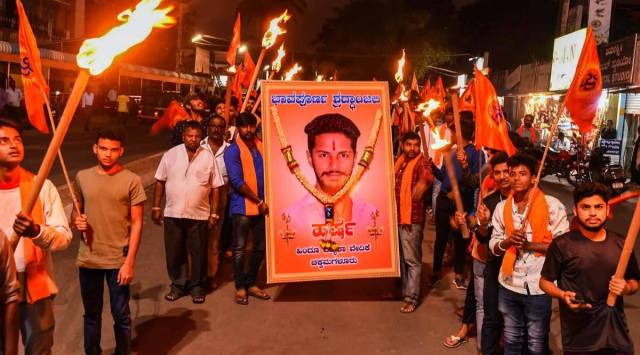Karnataka police hand Bajrang Dal activist murder probe to NIA
The NIA registered a formal complaint in the case of the murder of Bajrang Dal activist Harsha Nagaraj alias Harsha Hindu, 27, in a New Delhi court Wednesday after being handed the investigation, police sources said.
 Harsha, a Bajrang Dal worker with a history of crimes in Shivamogga, was hacked to death by a local Muslim gang with whose members he allegedly had a long-running feud from around 2016 over local and religious issues. (PTI/File)
Harsha, a Bajrang Dal worker with a history of crimes in Shivamogga, was hacked to death by a local Muslim gang with whose members he allegedly had a long-running feud from around 2016 over local and religious issues. (PTI/File)The Karnataka Government has handed the investigation into the murder of a right-wing Bajrang Dal worker to the National Investigation Agency (NIA).
🗞️ Subscribe Now: Get Express Premium to access the best Election reporting and analysis 🗞️
Harsha Nagaraj alias Harsha Hindu, 27, was killed on February 20 in the Shivamogga region of the state. The NIA registered a formal complaint in a New Delhi court on Wednesday after being handed the investigation.
On March 2, the Karnataka Police invoked sections of the Unlawful Activities (Prevention)Act, 1967, against 10 persons arrested in the case.
The NIA is expected to seek custody of the arrested suspects to carry out investigations in Shivamogga. On February 22, Shobha Karandlaje, Union Minister of State for Agriculture and BJP leader from Karnataka, in a letter to Home Minister Amit Shah had sought a probe by the NIA into the murder case.
The invoking of the UAPA was seen as a precursor to the handing over of the investigations to the anti-terror agency, as sought by BJP leaders. “The UAPA has been invoked in the case. There is a suspicion of a larger conspiracy behind the murder than a localised rivalry,” a senior state police official had said.
Harsha, a Bajrang Dal worker with a history of crimes, was hacked to death by a local Muslim gang with whose members he allegedly had a long-running feud since 2016 over local and religious issues. Ten persons were arrested in the week after the murder. One of the accused Mohammed Kashif, 30, was in prison with Harsha in 2017. Several of the accused have multiple cases of assault, burglaries, and robberies registered against them.
Police sources said the murder was linked to a clash between Harsha and one of his attackers on the court premises around six months prior to the murder.












